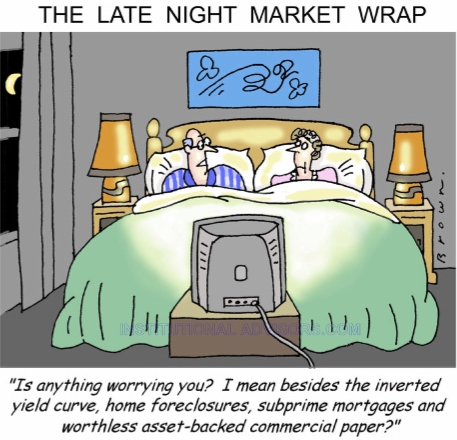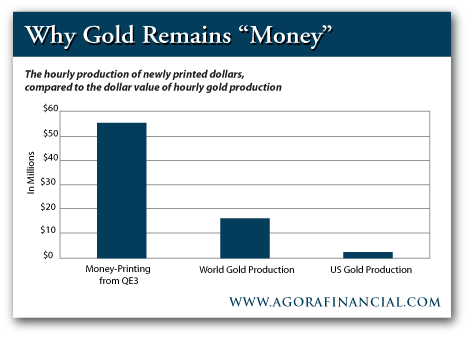
INSTITUTIONAL ADVISORS
FOR A FREE TRIAL GO HERE
THURSDAY, SEPTEMBER 27, 2012
BOB HOYE
PUBLISHED BY INSTITUTIONAL ADVISORS
The following is part of Pivotal Events that was
published for our subscribers September 20, 2012.
RHETORICAL ECONOMICS?
SIGNS OF THE TIMES
“Copper Surplus Presents Puzzle” – Wall Street Journal, September 11
“US Median Income Lowest Since 1995” – Financial Times, September 12
The number is down 4.1% since Obama took office. Table follows.
“No one will speculate against the unlimited power of a central bank. This is what stabilizes currencies of countries where investors know that. One wouldn’t gamble against the Federal Reserve, for example.” – European Central Bank Governing Council, Bloomberg, September 13
This boast could soon be another example of hubris. Wikipedia has a nice definition:
“Hubris often indicates a loss of contact with reality and an overestimation of one’s own competence or capabilities, especially when the person exhibiting it is in a position of power.”
An earlier example occurred with the boast about a “Dream Team” of economists in December 2007.
“Fed’s Facebook Poll Finds Public Anger at QE3” – Mortgage Orb, September 18
* * * * *
PERSPECTIVE
Last week’s comments included that the action was becoming compulsive. That would be for assets on the upside and the USD on the downside. On the decline, momentum on the USD continued down to 19 on the daily RSI. Last week we noted that it was approaching the level that would limit the move.
It’s there, and in going the other way narrowing credit spreads (junk vs. treasuries) have reached 78.5 on the RSI. This is the highest since early 2010 when that level exhausted the play.
Conditions are getting stretched and one wonders about what the elastic modulus of a financial bubble is. In 2000 this page invented the term “gossamer” limit. Whatever – practical instruction is not too far away.
CREDIT MARKETS
There are times when market prospects can be downright daunting. Like now, and the emotional side can be compared to standing at the top of a Double Diamond ski run, or in a whitewater kayak going into a rapid that is a grade more severe than your comfort level. Another analogy is driving a sports car at the end of a long straight and going into a hair-pin turn. A big adrenalin rush goes with trying to brake later than the other guy.
Typically over hundreds of years, if something bad is going to happen it will happen in the fall, and recent financial action has been outstanding enough to be followed by a setback. This has been accompanied by convictions within and without the Fed that intervention can boost the markets, whenever needed. Many technical and sentiment numbers suggest that this attempt is in the market.
That the Fed and ECB have talked up their hopes so much suggests a new school – Rhetorical Economics.
As noted above, junk bonds and spreads have been very exciting–along with the dreadful sub-prime mortgage bond. The later has soared in price from a panicked 38 last fall to 61 two weeks ago. Looked like panic buying. After a two-days of no change, it has dropped to 59 today. A distinctive drop – looking like the “Eiffel Tower” pattern that ended the long bond rally in June-July. Quite likely the Fed will have little problem in buying $50 billion per month.
They might have to buy more, after all the Fed generously exceeded its authority to buy bonds in the 1929 Crash – by a factor of six!
Long treasuries have firmed a little as other asset classes are stalling out. This could continue, but they are vulnerable to disappearing liquidity this fall.
Most other classes of bonds are very vulnerable.
COMMODITIES
Soybeans took out the 1700 level on this week’s decline to 1630. This dropped the grain index (GKX) down to 492, taking out support at 496. This one is technically vulnerable.
Base metal prices (GYX) have recorded the sharpest rally in a decade. Sharp approximates straight up and the last, but less vigorous, example occurred in early 2008. This one has recorded a huge swing from oversold to very overbought at 84 on Friday and is offering some perspective.
The cyclical high in 2007 set a big “Head and Shoulders” pattern, with the Head at 537 in 2007, the Left Shoulder at 490 in 2006 and the Right Shoulder at 527 in 2008. The crash-low was 187 in early 2009.
The next and likely cyclical peak has been focused with the Head at 502 in 2011, the LS at 430 in 2010 and the RS at 428, earlier this year. For us, the cyclical peak was confirmed by the 346 low in early August.
This summer’s surge is virtually exhausted at the 400 level. As noted, this is part of the overall rise, with the Fed and the ECB accelerating it to a compulsion that is measurable.
Crude oil joined the party and a couple of weeks ago accomplished a Sequential Sell pattern. Ross thought it could run for a few more bars – and it did that and then some – the high was 101.4 Friday.
Tuesday’s 4-dollar drop in 30 minutes was an alert to change. Crude often rushes up and then suffers a sharp hit on the way to an intermediate decline.
Yesterday’s ChartWorks updated the pattern.
AMPERSAND
A number of items recorded a reversal on September 14 and then today brought a setback to global equity markets. Perhaps related to news of European commercial banks losing deposits.
Technically, the action over the past three weeks has been impressive in forming so many excesses in so many different items. Ross is working on the review and it definitely is a cluster of signals.
Often a number different price-series get excited at the same time – just before a change.
In September 2008, we published our “Cluster Cluck” cartoon. It could be appropriate now and it follows.
for a Free Trial go HERE
BOB HOYE, INSTITUTIONAL ADVISORS
E-MAIL HYPERLINK “mailto:bhoye.institutionaladvisors@telus.net” bhoye.institutionaladvisors@telus.net
WEBSITE: HYPERLINK “http://www.institutionaladvisors.com” www.institutionaladvisors.com


























